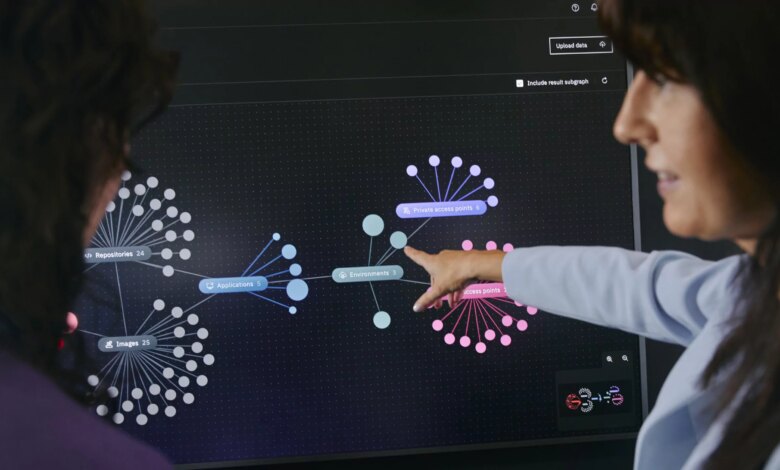
IBM® Cognos® Analytics has long been recognized as the gold standard in business intelligence (BI). Renowned for its superior reporting capabilities, IBM Cognos offers an unparalleled level of depth and flexibility for organizations looking to extract valuable insights from their data.
But what many might not know is how Cognos Analytics has seamlessly integrated artificial intelligence (AI) to revolutionize users’ BI experience. AI in Cognos automates many traditionally manual tasks.
It also enhances decision-making by uncovering hidden insights, predicting future trends and offering real-time guidance. These capabilities lend themselves to a vision for the next generation of BI, powered by IBM® Granite™ foundation models.
AI-powered features in Cognos Analytics today
IBM has embedded AI throughout Cognos Analytics to streamline processes, enhance data discovery and enable users to gain deeper insights with minimal effort. Here are some key features already transforming how businesses use Cognos:
Automated data preparation and classification:
Data preparation can be tedious and time-consuming, but Cognos Analytics simplifies it by automating the process. Users can connect to multiple data sources, clean and prepare the data, add calculated fields and join data sets, all without writing complex code. Notably, Cognos can automatically classify data types, identifying whether columns represent measures, geographic data or plain text, then tag them with relevant icons for improved visualization.
AI-powered data discovery:
Cognos Analytics helps users uncover relationships and patterns that might go unnoticed in traditional BI tools. With just a few clicks, you can use AI to surface hidden trends and key drivers, enabling you to explore relationships and insights in ways that manual analysis might not reveal.
AI assistant for natural language queries:
The AI Assistant in Cognos enables users to ask business questions in plain language and get immediate answers. Users can type their query and the assistant either returns an answer or generates a visualization, chart or even a complete dashboard, all from a natural language interaction.
AI insights for deeper understanding:
Beyond visualization, Cognos uses AI to generate valuable natural language insights directly from your data. These insights help users fully understand their data.
Forecasting for future decision-making:
Cognos Analytics also includes powerful forecasting capabilities, enabling users to make informed decisions based on predictive insights. By analyzing historical data, Cognos can identify trends and provide forecasts. This empowers businesses to prepare for future challenges and opportunities.
How IBM Granite foundation models disrupt the BI market
While Cognos Analytics already offers powerful AI features, a new vision powered by IBM Granite foundation models is set to transform the future of BI. This new approach brings a more intelligent, intuitive and adaptive BI experience. To begin with, here’s a look at some highlights of IBM’s vision for BI 3.0:
1. Conversational, zero learning curve experience
BI is simpler and more accessible than ever. The vision of BI 3.0 is a world where business users don’t need extensive training or deep data expertise. Instead, they interact with a conversational assistant, asking questions in natural language and receiving immediate, relevant answers. Say goodbye to complex interfaces and welcome seamless, intuitive data conversations.
2. AI-powered business advisor
The future of BI empowers users by providing them with an AI-powered business advisor that acts as a true partner in data-driven decision-making. Business intelligence is no longer limited to BI specialists. This assistant helps users who might not know exactly what to ask or how to interpret complex data scenarios.
- When users are unsure of what to ask, the assistant proactively suggests relevant questions based on the business context.
- When users are unclear about the meaning of certain trends or results, the assistant provides insights in simple, natural language.
- For forecasting, the assistant generates trend analyses and predictions, offering actionable insights that enable users to anticipate future outcomes.
- Also, if the assistant identifies a trend, it explains what is driving that trend, providing context on contributing factors, key drivers and offering potential actions users can take to influence the outcome.
The assistant provides a range of analytics—descriptive, diagnostic, predictive and prescriptive—making BI both accessible and actionable for everyone—whether they are a business executive, marketing manager or finance professional.
3. Intelligent metrics and alerts
Users can define the metrics and key performance indicators (KPIs) that matter most to them and monitor them in real time. Alerts notify users when thresholds are crossed or specific triggers are met, helping to ensure that critical changes are detected early. Users can track these metrics visually or receive updates automatically, enabling faster, more informed decision-making.
4. Adaptability for every user
BI solutions often force users to adapt to their platforms, but the next generation of BI adapts to users. The new AI assistant can understand business language, recognize writing nuances and adapt to the user’s preferred way of asking questions.
Whether users want to explore data broadly or narrow their queries to specific contexts, the assistant provides a personalized and fluid experience. Also, users can seamlessly integrate BI into the collaborative tools they use daily.
5. Trust and explainability: AI you can trust
One of the biggest concerns about AI is trust, especially in critical business decisions. IBM is taking a proactive approach to addressing this concern. The new assistant uses the rigorously trained IBM Granite models while adhering to stringent standards for data privacy and compliance.
Importantly, the assistant only provides insights based on certified company data and metrics, helping to ensure that responses are grounded in fact, not general AI knowledge. Users also have access to a detailed explanation of how the AI reached its conclusions, helping to ensure transparency and accountability.
6. Automated data enrichment
For data analysts focused on data preparation and organization, there is good news: the new AI assistant automates the enrichment process. It streamlines the analysis and automatically assigns business context, saving analysts considerable time on manual tasks and significantly reducing the time to value.
7. Automated metrics creation
Even the task of creating metrics and KPIs is simplified. Data professionals with less experience or those who prefer not to build models manually can use AI to automate this process. With just a few clicks, they can select and enrich data, define goals, and publish key metrics to a centralized catalog, thereby streamlining BI processes for faster, more effective decision-making.
Cognos Analytics has already positioned itself as the leader in AI-powered BI. But the future is even more exciting. IBM’s vision for BI 3.0, powered by its Granite foundation models, augments the current Cognos Analytics experience. It redefines how businesses interact with their data, making BI more conversational, intelligent and accessible than ever before.
With IBM at the forefront, the future of BI provides an adaptive, trustworthy and highly efficient experience, revolutionizing how organizations make data-driven decisions.
Explore a comprehensive BI solution
Was this article helpful?
YesNo
Source link





